Popups are like the billboards of the digital highway; properly implemented, they catch your attention for all the right reasons.
Persistent popups remain visible on users' screens through multiple interactions or until a specific action is taken, making them a powerful tool for increasing user engagement and conversion rates. Unlike traditional popups that disappear once dismissed, persistent popups stay with the user as they navigate through the website, providing a constant reminder of offers, updates, or essential information.
This consistent interaction model is especially beneficial in digital marketing where visibility equals opportunity. Here's how you can harness the power of persistent popups to enhance your digital strategy:
User Engagement: Engage users with timely and relevant content that adds value to their website experience.
Conversion Optimization: Increase conversion rates by keeping important calls-to-action in constant view.
Brand Reinforcement: Constant exposure helps reinforce your brand messaging and encourages deeper interaction with your content.
To effectively leverage persistent popups, it is crucial to balance their persistence with user experience to avoid intrusiveness. The goal is to enhance the user journey on your website, not hinder it.
Understanding Persistent Popups

Persistent popups are designed to stay visible on the screen until the user takes a specific action, such as signing up for a newsletter or closing the popup manually. This type of popup is crucial for campaigns where ongoing visibility can lead to higher engagement rates.
Key Features of Persistent Popups:
Non-dismissal: They remain active until the required action is taken.
High visibility: Continuously visible during the user’s visit, ensuring the message cannot be missed.
Customizable triggers: Activated by various user behaviors or set to display at specific times.
Differences Between Persistent and Regular Popups:
Persistence: Unlike regular popups that disappear once closed, persistent popups stay until action completion.
Engagement: Persistent popups are more aggressive, which can be more effective in capturing attention.
Flexibility: They often offer more complex triggers and conditions for display, tailored to user behavior.
Benefits of Persistent Popups

Persistent popups offer several significant advantages that can substantially enhance user interaction and conversion rates on digital platforms:
Increased User Engagement: By maintaining visibility, these popups keep the message in front of users, increasing the likelihood of interaction.
Higher Conversion Rates: Persistent popups have been shown to convert more users by constantly reminding them of the offer, which can lead to more completed actions such as sign-ups or purchases.
Improved Brand Visibility: These popups ensure that your brand or message gains more exposure during a user’s visit, helping to increase brand recall.
Enhanced User Experience: When implemented intelligently, persistent popups can offer information or discounts just when the user might need them, enhancing their overall site experience.
Use Cases for Persistent Popups
Persistent popups are versatile tools in digital marketing, useful across various scenarios to enhance user interaction and business goals:
E-commerce Promotions: They can effectively promote limited-time offers or flash sales, keeping the deals top-of-mind for shoppers.
Newsletter Sign-Ups: By persistently reminding visitors to subscribe, these popups can significantly increase email list sign-ups.
Event Registrations: Persistent reminders about upcoming events can boost registration rates by keeping the event visible to potential attendees.
Survey and Feedback Collection: Encouraging users to provide feedback before they exit can improve engagement and provide valuable insights into user experience.
Designing Effective Persistent Popups
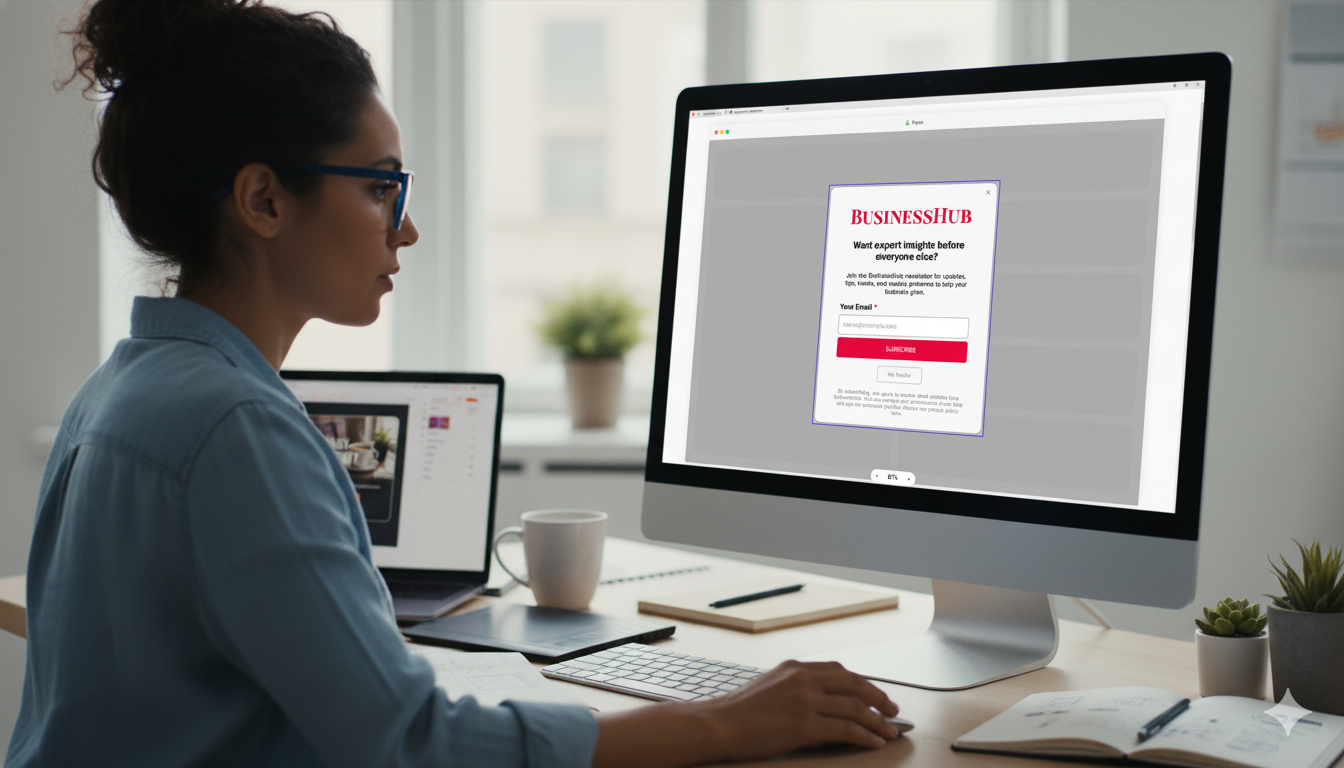
Creating persistent popups that capture attention and drive user action requires thoughtful design and strategy:
Crafting Compelling Headlines: The success of a popup often hinges on the strength of its headline. A powerful, clear headline grabs attention and communicates value immediately.
Importance of Visual Appeal: Attractive design can make or break the effectiveness of a popup. Utilizing eye-catching graphics and a harmonious color scheme can enhance the user's visual journey.
Keeping Messages Clear and Concise: Users typically spend only seconds deciding whether to engage with a popup. Concise, direct messages ensure the core information is communicated quickly.
Using High-Quality Images and Videos: High-resolution images and professional videos can increase engagement, making the popup more appealing and effective.
Key Elements of Successful Persistent Popups
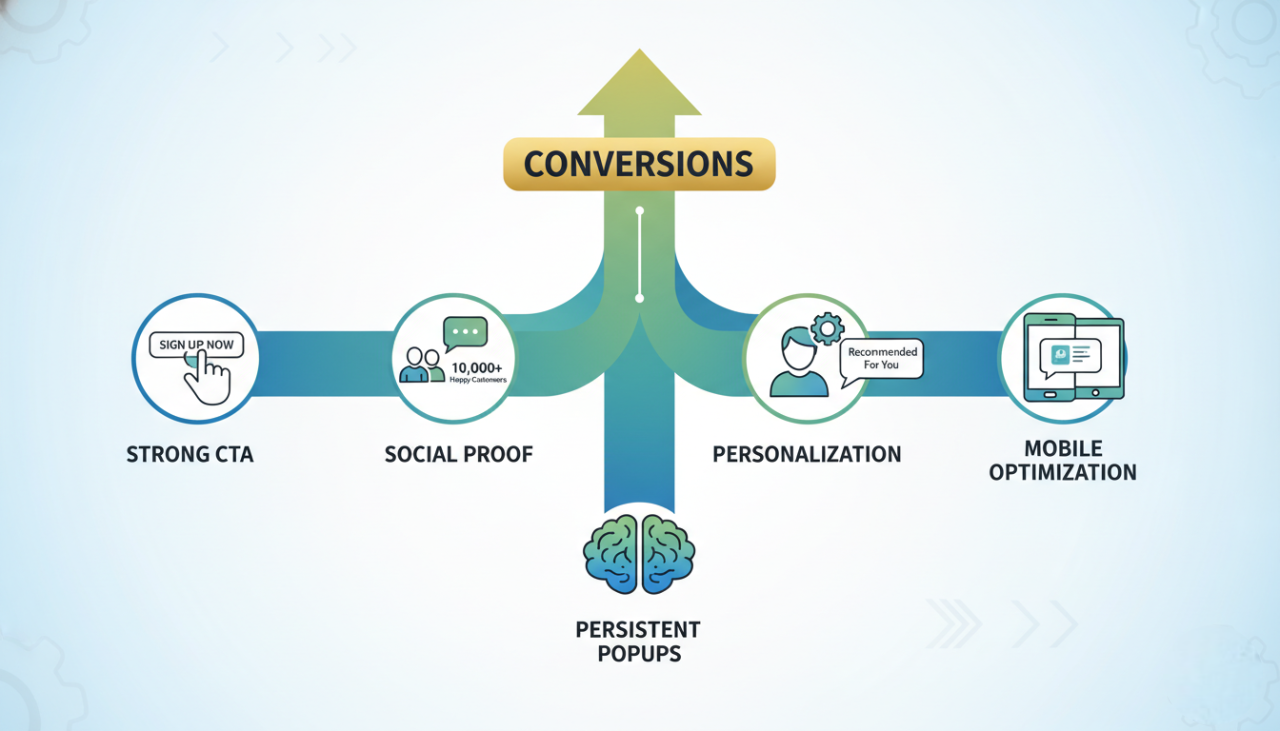
Effective persistent popups are characterized by several essential elements that significantly boost their performance:
Strong Call to Action (CTA): A clear and compelling CTA is crucial for guiding users on what steps to take next—whether that’s signing up, buying, or learning more.
Use of Social Proof: Incorporating elements like testimonials, customer counts, or ratings can greatly enhance trust and encourage user action.
Personalization Techniques: Tailoring content to match user preferences or past behavior can lead to higher engagement rates.
Mobile Optimization: Ensuring popups look great and function well on mobile devices is essential, as a significant portion of web traffic comes from mobile.
Timing and Placement Strategies
Effective timing and strategic placement are critical for maximizing the impact of persistent popups:
Best Times to Display Persistent Popups: Timing your popups for when users are most likely to be engaged (such as after reading an article or during checkout) can significantly increase their effectiveness.
Optimal Placement on Your Website: Placement matters—locating popups where they are easily noticeable yet not obstructive is key. For instance, popups that appear in the lower corner of the screen tend to be less intrusive.
Using Exit-Intent Technology: This technology triggers a popup when a user is about to leave the page, providing a last chance to capture their interest or offer value.
Frequency Capping to Avoid Annoyance: To prevent popup fatigue, it’s important to limit how often the same user sees a popup. Setting a cap ensures popups remain effective without becoming a nuisance.
Integrating Persistent Popups with Marketing Channels
Integrating persistent popups effectively with various marketing channels can amplify their impact:
Email Marketing Integration: Link popup content with email campaigns by using popups to encourage newsletter sign-ups or offer personalized promotions based on the subscriber's past behaviors.
Social Media Promotion: Use popups to promote social media contests or share specific content, encouraging users to follow your social platforms.
SMS and Push Notifications: Coordinate popups with SMS or push notifications to create a unified marketing message that reaches users both on and off your site.
Website Integration: Ensure that popups complement and enhance the overall website experience rather than detract from it, by aligning them with the site's design and content strategy.
Tools and Platforms for Creating Persistent Popups

Selecting the right tools and platforms is crucial for designing and managing effective persistent popups:
Popular Popup Creation Tools: Platform like Poper offer extensive features for creating and scheduling popups, providing a range of options for customization and targeting.
Key Features to Look for in Popup Tools: When choosing a tool, prioritize ease of use, flexibility in design, advanced targeting options, and integration capabilities with other marketing tools.
Introduction to Poper’s Persistent Popup Capabilities: Poper stands out with its user-friendly interface and powerful customization options that allow marketers to create highly effective persistent popups. It offers features like AI-driven design suggestions, real-time analytics, and seamless integration with major marketing platforms.
Step-by-Step Guide to Creating Persistent Popups with Poper
Creating effective persistent popups using Poper involves several key steps to ensure they are both engaging and functionally integrated into your marketing efforts:
Step-by-Step Guide to Creating Persistent Popups with Poper
Creating persistent popups with Poper involves a series of straightforward steps. Follow this guide to set up effective and engaging popups.
Step 1: Create a New Popup
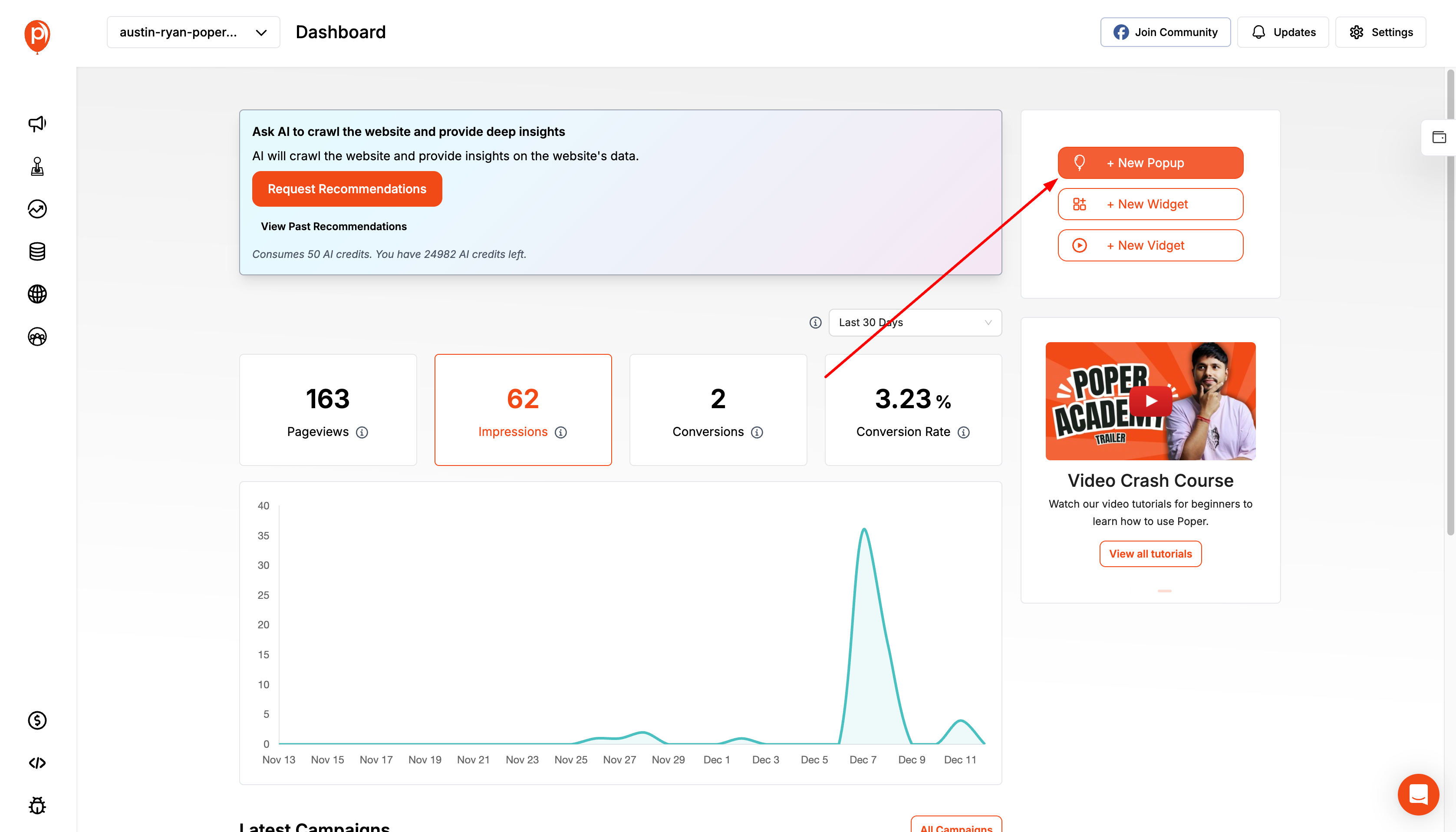
Open your Poper dashboard and click on the "+ New Popup" button. This will prompt you to either choose from a variety of templates or start from scratch.
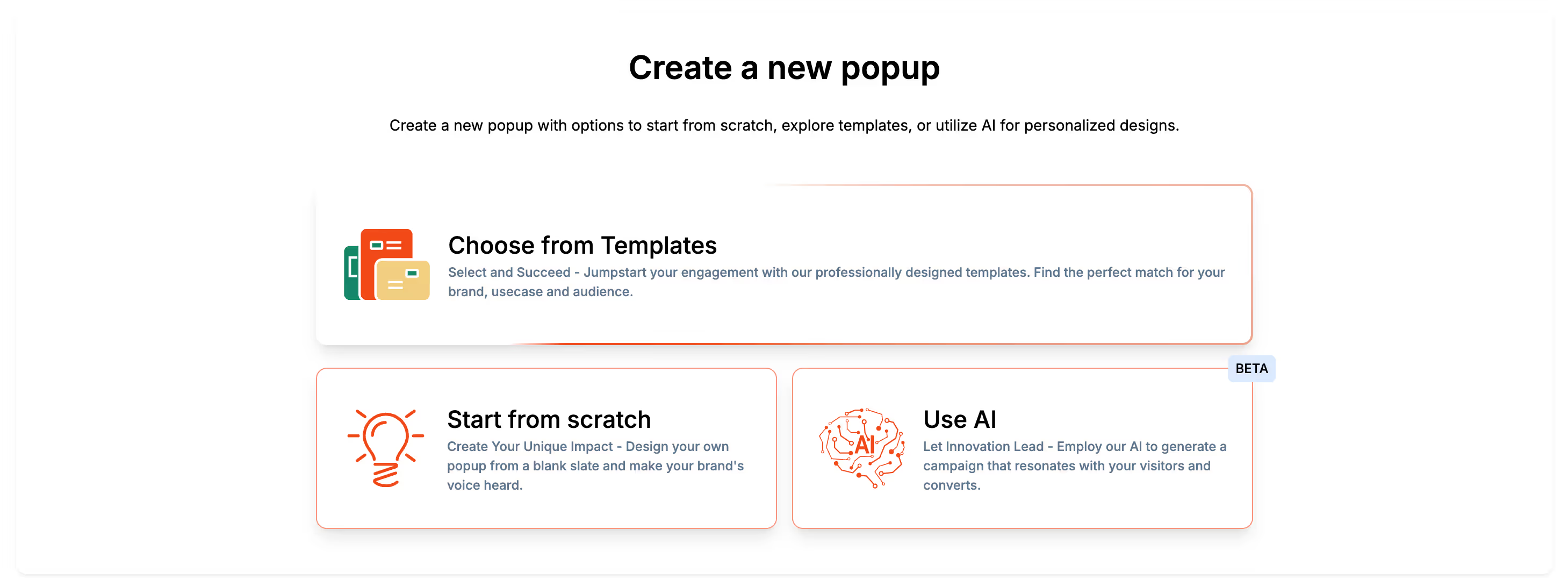
Step 2: Choose Your Desired Template

Browse through the available templates and select the one that best fits your campaign needs. Templates help you jumpstart your design with pre-built options.
Step 3: Access Global Settings
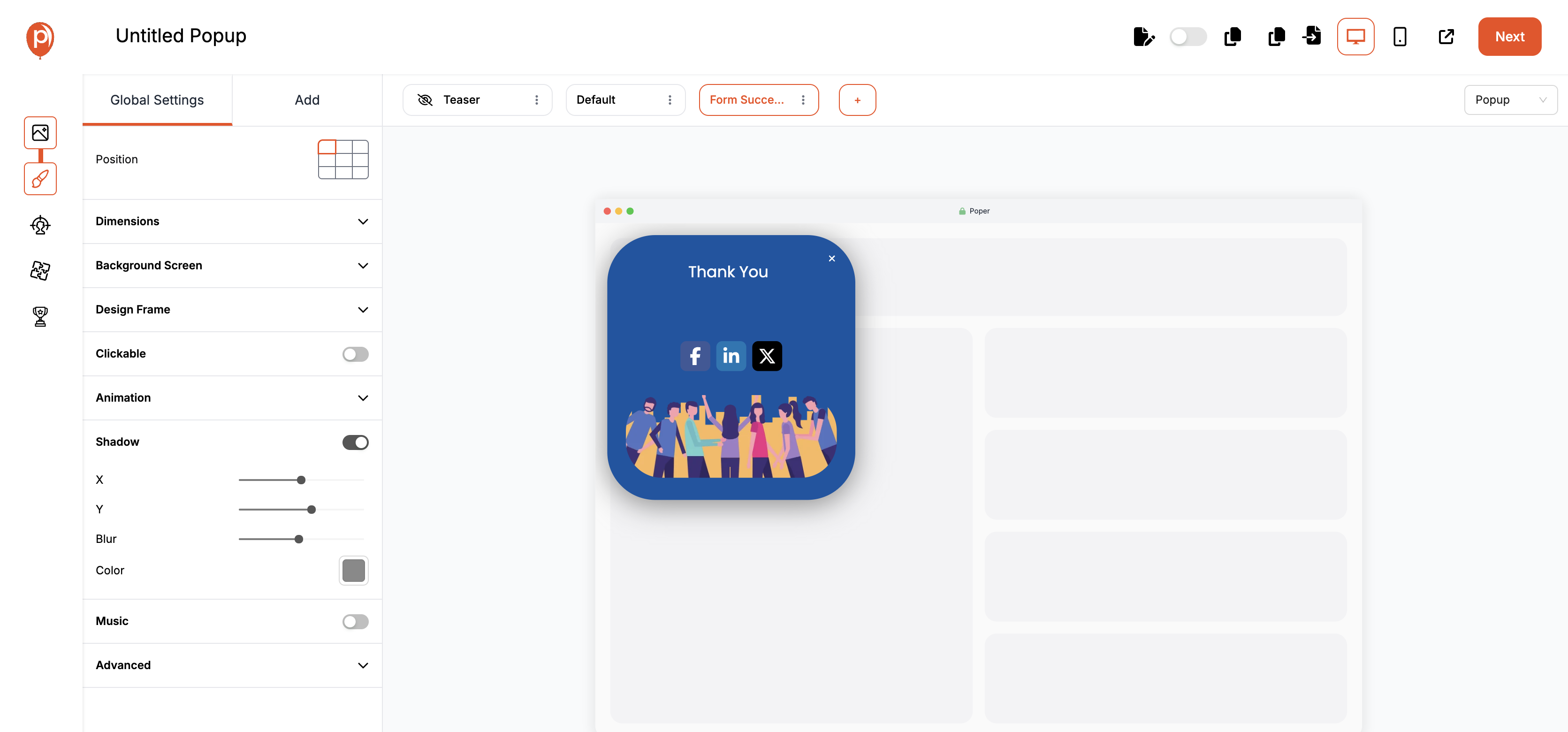
Once you have your template, click on the "Global Settings" button on the right-hand side of the editor to adjust overall settings for your popup.
Step 4: Configure Background Overlay
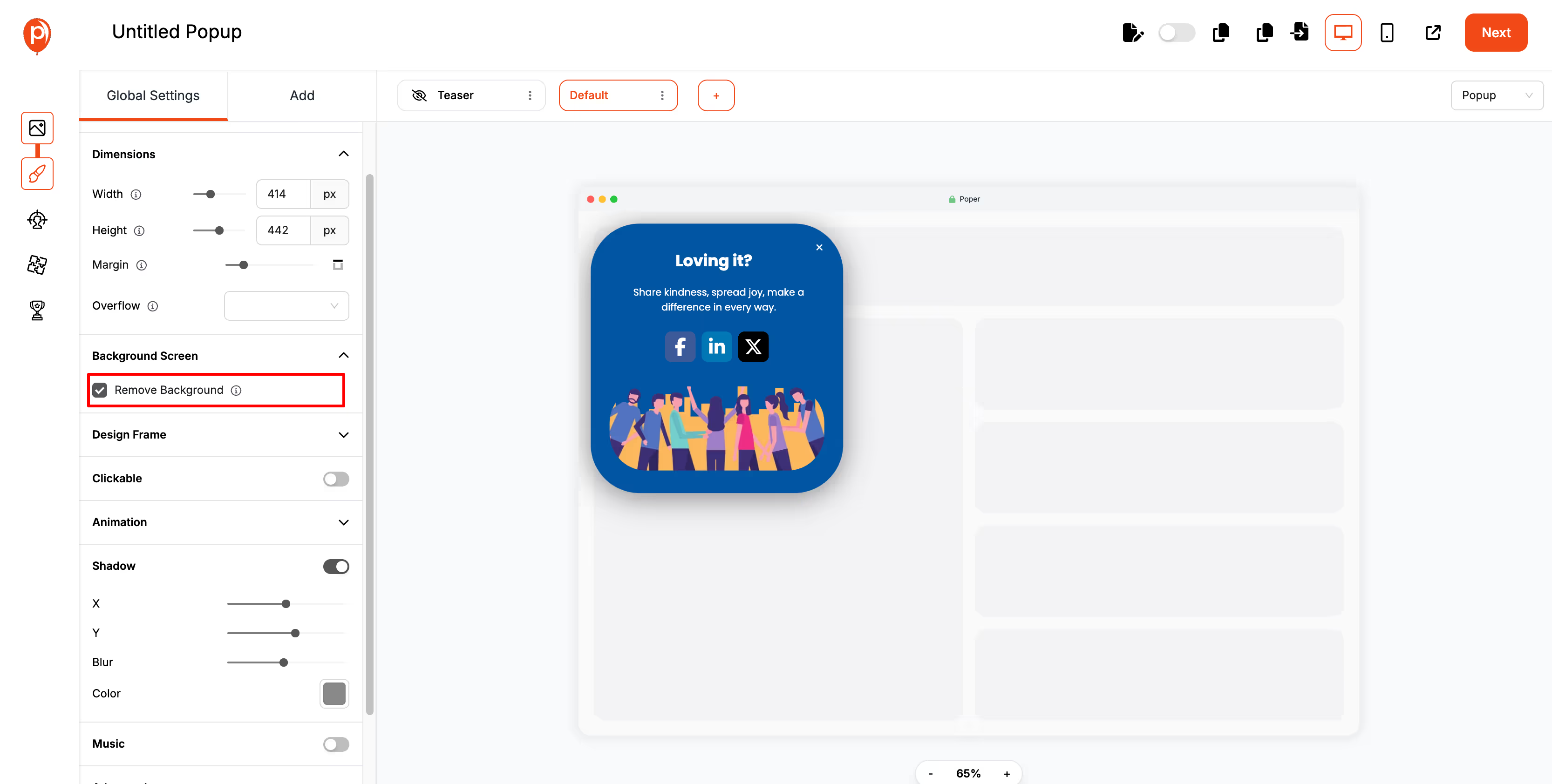
In the Global Settings, toggle the "Hide Background Overlay" option to control whether your popup has a background overlay.
Turn this setting on to remove the background overlay, making your teaser float and allowing users to interact with other elements on your website.
Step 5: Set Display Triggers
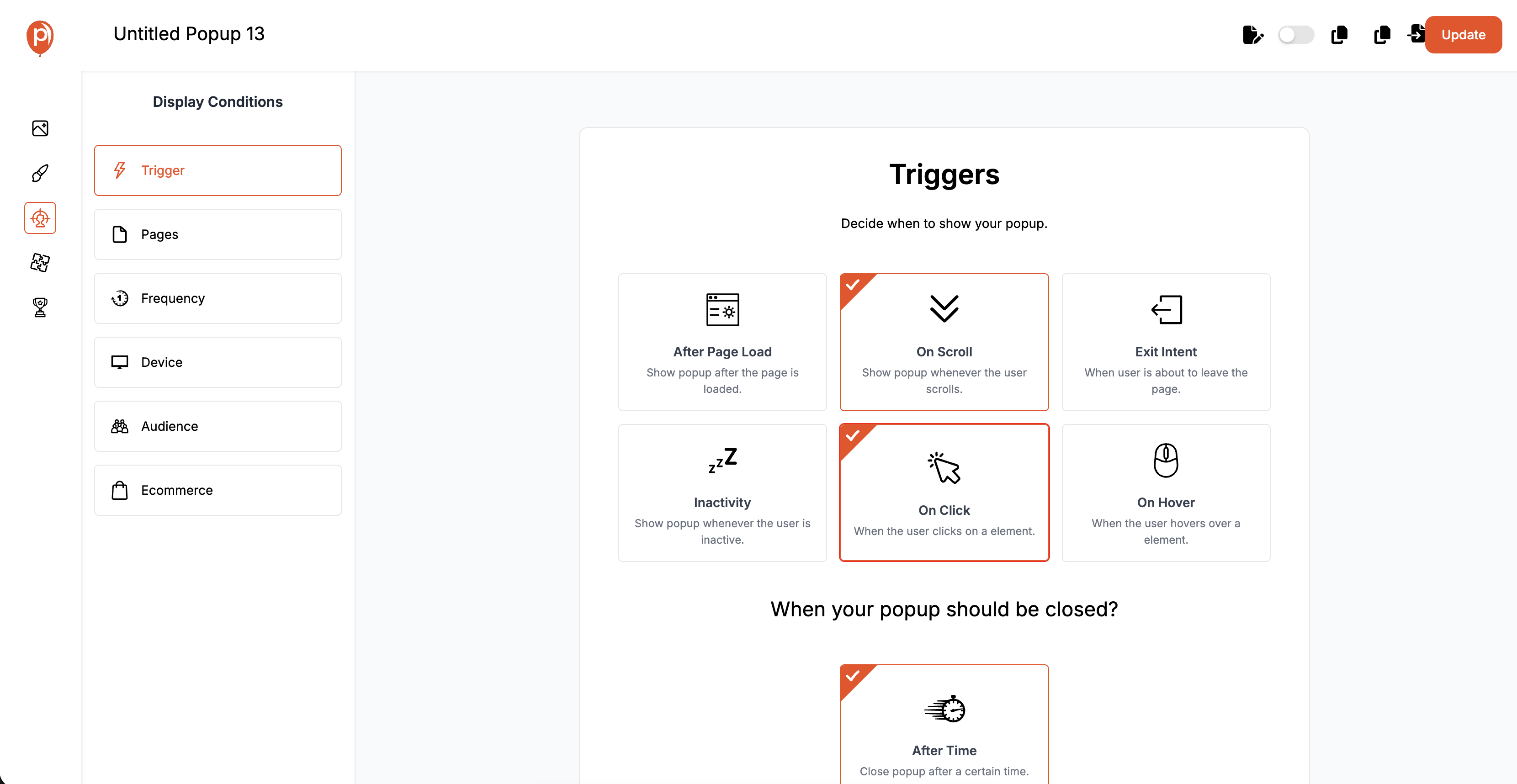
Next, navigate to the "Display Triggers" section. Choose when and how your popup will appear based on user behavior such as scrolling, inactivity, exit intent, clicking, or hovering.
Step 6: Save and Publish
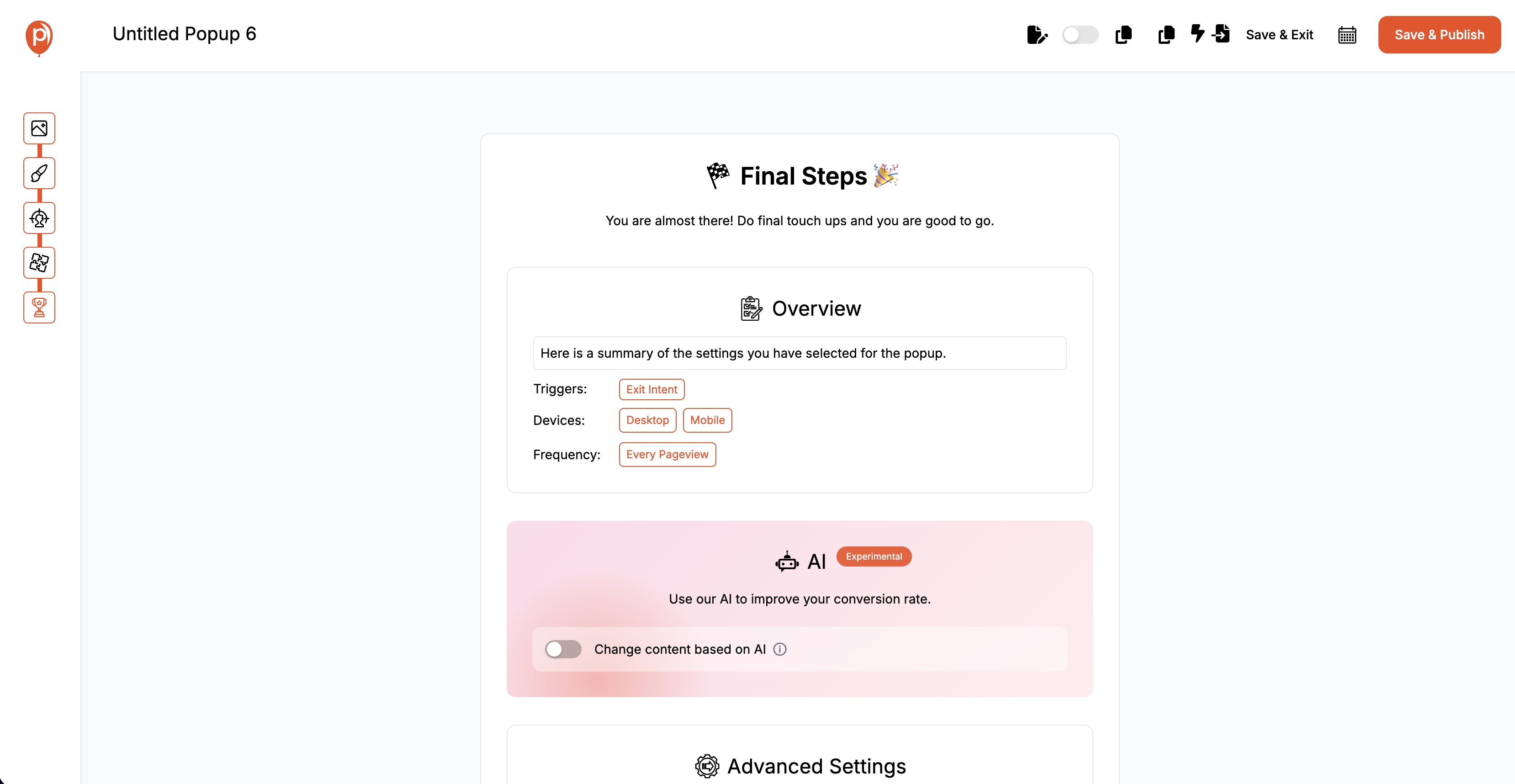
Finally, review your settings and click on the "Save & Publish" button to deploy your persistent popup on your website.
By following these steps, you can effectively create and customize persistent popups using Poper, enhancing user engagement and achieving your marketing goals.
Best Practices for Persistent Popups
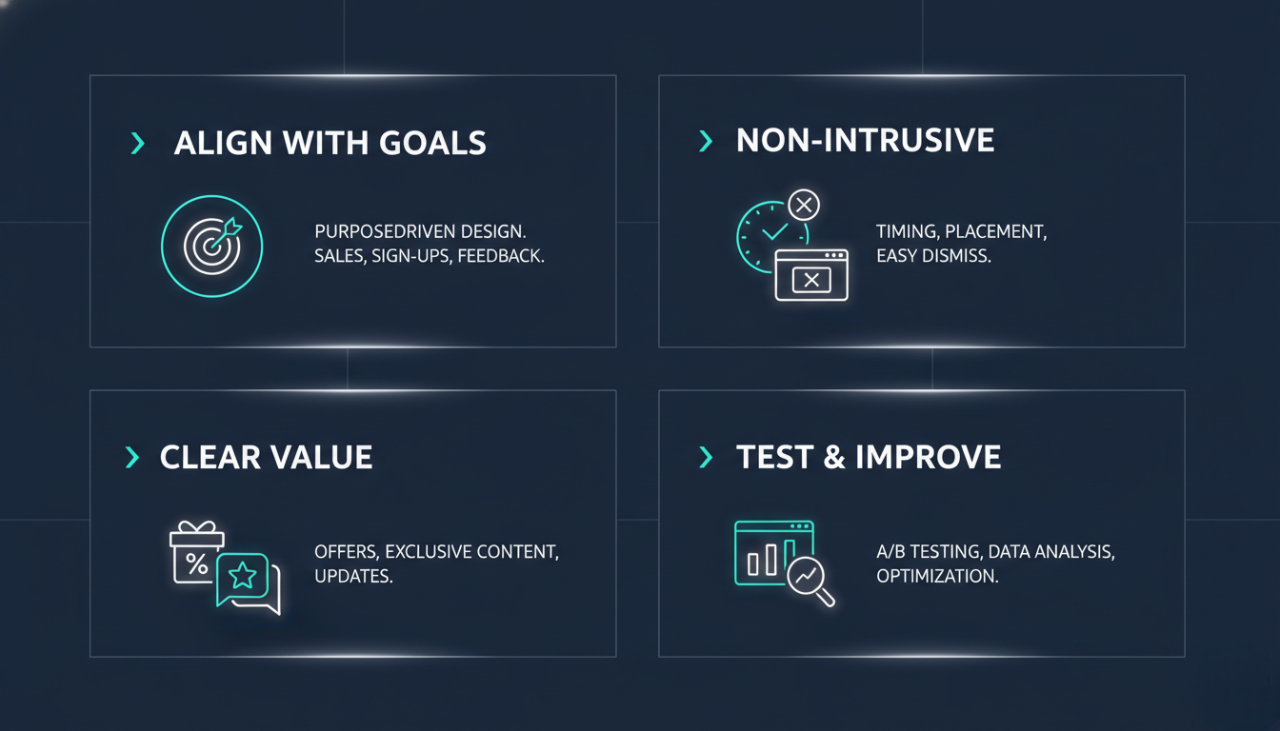
Adopting best practices for persistent popups is essential to optimize their impact without detracting from the user experience:
Aligning Popups with Campaign Goals: Ensure that your popups serve a clear purpose that aligns with your broader marketing objectives, whether that's driving sales, promoting registration, or collecting feedback.
Ensuring Popups Are Non-Intrusive: Design your popups to be informative without being disruptive. This means considering the timing of their appearance, their placement on the page, and how easy it is for users to dismiss them if they choose.
Providing Clear Value Propositions: Each popup should offer something valuable to the user. This could be a discount, exclusive content, or important information about updates or changes.
Continuously Testing and Improving: Use A/B testing to try different versions of your popups to see which ones perform best. Analyze the data collected through these tests to make informed decisions about future popup strategies.
Advanced Techniques for Persistent Popups
To further enhance the effectiveness of your persistent popups, consider implementing these advanced techniques:
Dynamic Content in Persistent Popups: Customize popups to display different content based on user behavior or demographic data. This ensures that each user sees the most relevant and engaging message.
Using AI for Intelligent Popup Scheduling: Employ artificial intelligence to analyze user data and determine the optimal timing for displaying popups. AI can help predict when users are most likely to engage, increasing the chances of conversion.
Integrating Popups with CRM and Marketing Automation Tools: Connect your popup system with customer relationship management and marketing automation platforms. This integration allows for seamless data flow and helps personalize user interactions based on their history with your brand.
Analyzing the Performance of Persistent Popups
To ensure your persistent popups are achieving their intended goals, it's crucial to analyze their performance regularly:
Key Metrics to Track: Focus on metrics such as conversion rate, engagement rate, and exit rate. These indicators will help you understand how effectively the popups are driving user actions and maintaining interest.
Using Analytics for Performance Improvement: Implement tools like Google Analytics to delve deeper into the data. Look at user paths, interaction times, and bounce rates associated with the popups. This analysis can reveal insights about what's working and what might need adjustment.
Continuous Improvement Based on Data Insights: Use the collected data to refine and optimize your popup strategies. If certain popups are underperforming, test new variations with different content, layouts, or triggers. Always aim to enhance the user experience while striving for higher conversion rates.
Common Mistakes to Avoid with Persistent Popups
To maximize the effectiveness of persistent popups, it's crucial to be aware of common pitfalls:
Overloading Users with Information: Overly complex or cluttered popups can overwhelm users, leading to negative experiences and lower engagement. Keep your messages succinct and focused.
Poor Mobile Experience: Failing to optimize popups for mobile devices can alienate a large portion of your audience. Ensure your popups are responsive and non-disruptive on all devices.
Lack of Personalization: Generic popups may fail to resonate with users. Tailoring content to individual preferences and behaviors can significantly increase relevance and effectiveness.
Ignoring Data Privacy Concerns: With growing sensitivity around data privacy, it’s vital to ensure your popups comply with regulations like GDPR and respect user preferences regarding data handling.
Future Trends in Persistent Popups

As technology evolves, so do the strategies for engaging users through persistent popups:
AI and Machine Learning Integration: Future popups will increasingly leverage AI to analyze user behavior and optimize timing and content, making interactions more personalized and effective.
Enhanced Personalization Techniques: Advances in data analytics will allow for even more precise targeting, delivering content tailored to the individual preferences and behaviors of users.
Increased Use of AR and VR: Augmented and virtual reality technologies are set to transform the popup experience, offering immersive and interactive ways to engage users.
Focus on User Privacy and Consent: As privacy concerns continue to grow, transparent practices and respect for user consent will become even more crucial in popup strategies.
Frequently Asked Questions (FAQs)
What are the benefits of using persistent popups?
Persistent popups remain visible until the user interacts with them, increasing the likelihood of engagement and conversion. They ensure important messages aren't missed and can significantly boost user actions like sign-ups or purchases.
How can I ensure my persistent popups are effective?
To make persistent popups effective, focus on compelling design, clear messaging, and strategic placement. Use A/B testing to refine and improve their performance continually.
How can I integrate persistent popups with my marketing strategy?
Integrate persistent popups with your marketing strategy by aligning them with your campaign goals, using them to capture leads for email marketing, promoting social media channels, and coordinating with SMS or push notifications.
How often should I update my popup strategy?
Regularly review and update your popup strategy based on performance data. This can be done quarterly or whenever you notice a decline in engagement metrics.
What are common mistakes to avoid when using persistent popups?
Avoid overloading users with information, failing to optimize for mobile devices, lacking personalization, and ignoring data privacy concerns.
How do I measure the success of my persistent popup campaigns?
Track key metrics like conversion rates, engagement rates, and exit rates. Use analytics tools to gather insights and continuously improve your popup strategy.
Can persistent popups improve my conversion rates?
Yes, by remaining visible and relevant, persistent popups can significantly enhance conversion rates by prompting users to take desired actions.
What types of events or promotions benefit most from persistent popups?
E-commerce promotions, event registrations, newsletter sign-ups, and survey or feedback collection benefit greatly from persistent popups.
How can I ensure my persistent popups are mobile-friendly?
Design popups with responsive layouts, test them on various devices, and ensure they are non-intrusive on smaller screens.
Summary
Persistent popups are a powerful tool in digital marketing, ensuring that critical messages remain visible until acted upon, thereby enhancing user engagement and conversion rates.
The key to successful persistent popups lies in continuous testing and optimization. Regularly update your strategy based on data insights to maintain and improve popup effectiveness. Stay ahead of trends and ensure compliance with privacy regulations to provide a positive user experience.




